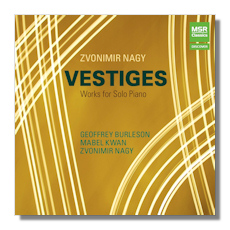
The Internet's Premier Classical Music Source
Related Links
- Latest Reviews
- More Reviews
-
By Composer
-
Collections
DVD & Blu-ray
Books
Concert Reviews
Articles/Interviews
Software
Audio
Search Amazon
Recommended Links
Site News
 CD Review
CD Review
Zvonimir Nagy

Vestiges
- Of The Lake I (2007; rev. 2014) 1
- Illusion (2002) 2
- And So She Said (2005) 2
- Vestiges (2003-04) 2
- Of The Lake II (2010) 1
- Touché (2003) 2
- Canon – Inner Self (2007) 3
- Sonata (1998) 2
- Of The Lake III (2014) 1
1 Geoffrey Burleson, piano
2 Zvonimir Nagy, piano
3 Mabel Kwan, piano
MSR Classics MSR1515 67:37
Croatian-born, Pittsburgh-based Zvonimir Nagy (b. 1978) may very well be a talented composer, perhaps immensely talented. But frankly, this disc should not be used as an example of his better work. It is chock full of ponderous, very slow, dissonant and sparsely textured music. Let me say to those who suspect I'm unwilling to embrace the new or the challenging in music that I have reviewed works of Boulez, Berio, Ligeti and some from the far reaches of computer processed music, all of which have found favor with me to one extent or another. So, my judgments here are not based on bias or preconceived notions about progressive types of music.
The first piece on the disc, of the lake I, is agonizingly slow, with single notes struck to convey a sense of wandering or discovery, or so it seems. Those notes come grudgingly, as if the composer were stingy with them in his need to keep the music's sound world free of clutter. Moreover, often they are held very long, as if the single note contains a beauty within itself. Eventually a discernible direction forms and the work develops tension, but much too late to rescue the listener from its overall boredom. The next piece, Illusion, is hardly any better: it draws some thematic material from Sonata (track 8 here) and effectively creates a sense of mystery and enigma, but at the expense of the listener's patience as events unfold at a glacial pace. Not a bad piece then, but hardly compelling. The third piece, And so she said, shows some life, but is ultimately of only marginal interest.
Vestiges, the album's title work, comes next. According the the album notes, the composer applies "a computer-generated series of compression and expansion procedures to the constituent intervals of the harmonic series on B flat." Got that? Alas, despite its artificial intelligence-parentage, this piece seems cut from the same cloth as the previous music: slow, threadbare, and with a sense of wandering or misdirection that leads the music mostly to nowhere. For the first half of this twenty-one minute piece very little seems to happen, but midway through, the music takes on a true feeling of direction: tension breaks out, and a titanic struggle against a sense of collapse takes hold. But soon stasis, slow-motion stasis at that, sets in again and our hopes of something meaningful happening are dashed. The next piece, of the lake II, features a lot of meandering in the upper register and not much else. Touché is slow and, well…uneventful, with lots of repeated notes, chords or trills, and thus not breaking the unforgiving trance-like trend here. The ensuing pieces fare little better, though Sonata has some interesting moments wherein Nagy sounds remotely like a cross between Bartók and Debussy.
What I find additionally disappointing about the music is that even Nagy's style comes across as a bit stale and faceless. It sounds familiar, like much keyboard music from the late 20th or early 21st century avant-garde. It struck me as being somewhat akin to the style of American composer Nils Vigeland (b. 1950), who seems a bit more vital and more approachable, not that I would write home about his music, either. The performances by the various pianists on this MSR CD, including Nagy himself, seem to be very good and the sound reproduction is excellent. You may find this kind of watching-paint-dry art to your liking. I don't. But everything here is well done and to be fair to the music, perhaps I'm missing something in it, something beneath the surface. I'm certain that Mr. Nagy's admirers will find this music intriguing and perhaps some patient progressive-minded listeners will as well.
Copyright © 2015, Robert Cummings




















